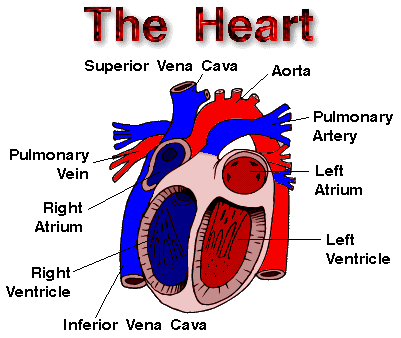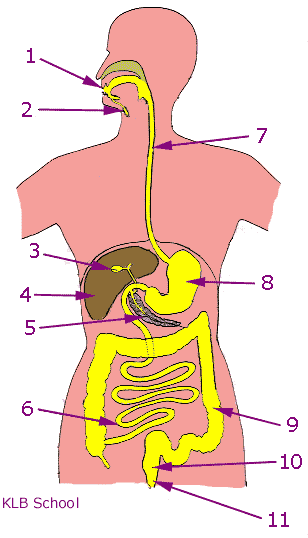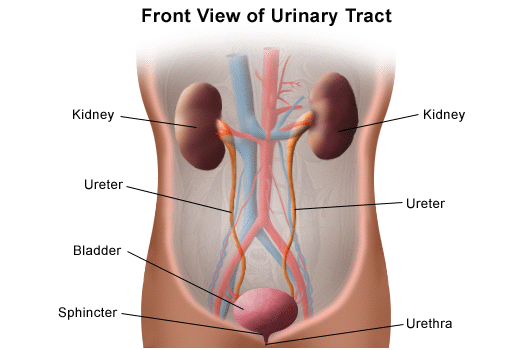Учебное пособие по англ языку. Анатомия человека
 Скачать 4.92 Mb. Скачать 4.92 Mb.
|
Blood and its elementsBlood is a fluid connective tissue with many various functions. Many important physiological process take place in the blood. It also determines the activity of separated body cells. Blood is composed of plasma and the cellular elements. They are red blood cells (erythrocytes), white blood cells (leukocytes) and blood platelets (thrombocytes). About 65 per cent of all white cells are leukocytes. Their protoplasm contains granules. One characteristic of leukocytes is the lobed appearance of the nucleus. The number of lobes is thought to be an index to the cell’s age. About 45 per cent of all leukocytes have a nucleus of three lobes. The life span of a leucocyte is short, from 4 to 12 days. The function of leukocytes is to protect against infection. After the skin is pierced and the wound becomes infected, leukocytes from all the body are attracted to this place. Arriving at the wound, they leave the blood stream. They engulf the bacteria within their own protoplasm. This process is called phagocytosis. Erythrocytes are the most numerous cellular elements. Red corpuscles have two physical features which are very important in the function of respiration. They have great elasticity and flexibility. These features give them the possibility to pass through very small capillaries. The most important part of the red cell is its red substance or hemoglobin. The average human blood volume is not less than 7.5% but not more than 10% of the body weight. 4.Do the tasks according to the variants Variant 1 Fill in the table using the information below
White corpuscles; numerous cellular elements; have elasticity and flexibility; have granules in the protoplasm; pass through small capillaries; have a short span of life; have a lobed appearance of the nucleus; take part in the function of respiration; contain red colouring substance ( hemoglobin ); protect against infection; arrive at the wound and engulf the bacteria. Variant 2 Answer the questions to the text “Blood and its elements”. Translate the answers. 1.What kind of tissue is the blood? 2.What is the blood compose of ? 3.What is the charachteristic of leukocytes? 4.What is the function of leukocytes? 5.What do leukocytes do when a wound becomes infected? 6.What are the most numerous cellular elements? 7.What features do erythrocytes have? 8.What is the important part of erythrocytes? 9.What is the total blood volume divided into? Variant 3 Translate into English using the text “Blood and its elements”.
Variant 4 Continue the sentences using the text “Blood and its elements”. Translate the sentences.
Variant 5 Match the parts of the sentences using the text “Blood and its elements”. Translate the sentences.
8. Match the idiomatic expressions with their definitions. Learn them
9. Answer the questions 1.Have you ever got situations which chill your blood? 2.Do you have examples when you can’t blood out of a stone? 10.Speak about blood. TOPIC 11. THE CARDIOVASCULAR SYSTEM 1. Fill in the gaps with the missing remarks Teacher: Good day. Glad to see you and I mean it from the bottom of my heart. Do you know what it means. Student: … Teacher: What do you usually do from the bottom of your heart? Student: … Teacher: Let’s see how our heart works. 2. Study the new words. Learn them.
3. Read the text. Pay attention to the new words for better understanding. The Cardiovascular System The cardiovascular system is the system of blood circulation. It includes the heart, the arteries, the veins and the capillaries. The centre of the circulatory system is the heart. The heart is the size of about two fists. The normal weight of the heart is about half of one per cent of the total body weight. The human heart contracts from the first moment of life to the last one. The contractions of the heart pump blood through the arteries to all parts of the body. Blood flows through your body using your blood vessels such as capillaries, veins and arteries. When the oxygen-poor blood goes to your lungs, the blood will be oxygen-rich and will give oxygen to your whole body and does this over and over again. There are four chambers in the heart. There are two chambers on the top and two chambers on the bottom. The top two chambers are called the atria. There's a left atrium and a right atrium. They receive blood returning to the heart from the body and lungs. The bottom two chambers are the ventricles. There is also a right ventricle and a left ventricle. The ventricles give the blood to the body and lungs. The valves separate the atria from the ventricles. The valves are located at the entrance and exit of each ventricle. Each beat of the heart is followed by a period of rest for the cardiac muscle. Each wave of contraction and period of rest of the heart compose a cardiac cycle. The vascular system consists of three groups of vessels – arteries, veins and capillaries. The vessels carrying blood to and from the tissues of the body compose the general system. They are called the systemic vessels. The pulmonary system is formed by the vessels carrying blood to and from the lungs. The portal system is formed by the veins passing to the liver. 4. Write down the physical features of the heart. Speak about the heart according to the plan The Heart
5. Complete the sentences using the text “The Cardiovascular System”.
6. Match two parts of the sentences together.
7. Answer the questions
8. What do you think these idiomatic expressions mean. Learn them
9. Answer the questions
10. Speak English Скажите, что
11. Speak about the cardiovascular system TOPIC 12. THE RESPIRATORY SYSTEM 1. Fill in the gaps with the missing remarks Teacher: Good day. Nice to see you. Student: … Teacher: Imagine that you see your friend in the crowd. You want him to notice you. It is so noisy in the street. What will you do? Student: … Teacher: Yes, you will shout very loudly. It means you shout at the top of the lungs. Let’s see how strong our lungs are. 2. Look at the picture and writes down the English names of the respiratory organs. Nose 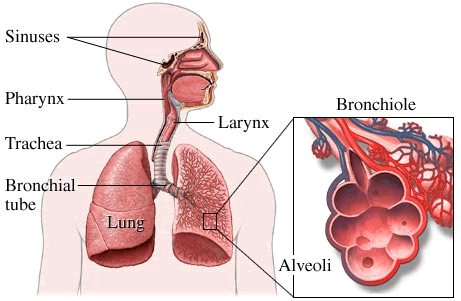  1.нос; 2. глотка; 3. гортань; 3. трахея; 4.бронхиальная трубка (бронх – bronchus, бронхи – bronchi); 5. лёгкое; 6. бронхиола; 7. альвеолы 3.Study the new words
4. Read the text. Translate the sentences with the new words from ex.3. The Respiratory System The respiratory system brings oxygen into the body and removes carbon dioxide. This process is called breathing. It consists of inspiration and expiration. The organs of this system are the nose, pharynx, larynx, trachea and lungs. When you breathe, air travels through your nose, down the trachea, and into bronchi. These bronchi branch into smaller passages called bronchioles and finally into small sacs called alveoli. The lungs are the most important organs of the respiratory system. There are two lungs in the body. The right lung has three lobes and the left lung has only two lobes. The lungs are separated by the mediastinum and covered by the pleura. They have bases, apexes, borders and surfaces. The average vital capacity is about 3-4 liters. During inspiration, the alveoli in the lungs are filled with air. It is here that oxygen is exchanged for carbon dioxide. Blood cells absorb oxygen from the capillaries in the alveoli, as carbon dioxide, a waste product, is released back into the lungs from the veins. During expiration, the carbon dioxide is expelled from the body. Oxygen-rich blood then travels to the heart so it can be pumped back to the body where it is needed. 5. Answer the questions
6. Complete the sentences
7. Put the sentences into the logical order When you breathe, the air:
8.Fill in the gaps using the text “The Respiratory System”.
9. Study the idiomatic expressions. Learn them
10. Translate into English.
11. Speak about the respiratory system TOPIC 13. THE DIGESTIVE SYSTEM 1. Fill in the gaps with the missing remarks Teacher: Good day. Nice to see you. Some people say I don’t live to eat but eat to live. What do you think this saying mean? Student: … Teacher: Do you agree with it? Student: … 3. Look at the picture. Translate the names of the digestive organs into Russian.
4. Read the description of the digestive organs and guess what they are. Pay attention to the given words for better understanding.
5.Fill in the gaps with the given words and read about the digestive process. The Digestive Process
The digestive system consists of (1)______________and digestive glands. The digestive tract is some 8-10m long and is divided into the following parts: oral cavity, (2)____________, stomach, small intestine and large intestine. The digestive process begins in (3)___________. The food is chewed by the teeth in the oral cavity. (4)______________secrete saliva which helps break down food’s carbohydrates. After that the food enters the esophagus. Peristaltic movements in the walls of the esophagus push the food into (5)________________. Food in the stomach is partly digested and converted into a semi liquid (полужидкий) state. After being in the stomach, food enters the small intestine. There (6) ___________, pancreatic enzymes, and other digestive enzymes help in the breakdown of food. Then food passes into the large intestine where some of the water and electrolytes are removed from the food. (7) _______________in the large intestine help in the digestion process. Solid waste products are stored in (8) ____________and then, eliminated from the body. 6.Translate into English using the text “The Digestive Process” 1)пищеварительные железы; 2) делиться на части; 3)пережевывать зубами; 4)выделять слюну; 5)расщеплять углеводы; 6)проникать в пищевод; 7) стенки пищевода; 8) проталкивать пищу; 9) превращаться в полужидкое состояние; 10) твёрдые остаточные продукты; 11) удалять из организма. 7.Choose the best ending for each sentence.
8 .Speak about the digestive system TOPIC 14. THE URINARY SYSTEM 1.Review the given words kidneys / bladder / to consist of / spine / cover / lumber region / fluid / to make up / the cavity of the pelvis / to form / muscular / smooth muscles / capacity / connective tissue / apex 2.Study the new words
3.Say into English using the words from exercises 1 and 2. 1.выделять остаточные продукты тела 2.состоять из почек, мочевого пузыря, мочеточников и уретры 3.располагаться в поясничном отделе позвоночника 4.покрывать (by) оболочкой 5.бобовидные органы 6.проводить мочу 7.состоять из слоев (покровов) 8.слизистая оболочка 9.образовывать складки 10.три слоя гладких мыщц 11.растягиваться в разных направлениях 4.Answer the questions
5.Give the definition (определение) of the words
6.Fill in the gaps using the text
7.Translate the sentences into Russian. 1.The bladder is a reservoir for urine. 2.It is situated in the cavity of the pelvis. 3.The bladder has three parts: apex, body and fundus. 4.The wall of the bladder consists of three coatings – mucous, muscular and connective tissue. 5.The mucous membrane of the bladder forms numerous folds. 6.When the bladder fills, the folds of the mucous coat straighten out. 7.The muscular coat consists of three layers of smooth muscles extending in different directions. 8.The capacity of the bladder of an adult is about 350 – 500 ml. 8.Match the words in the columns
9.Continue the sentences
10.Translate into English
11.Answer the questions
12.Speak about the urinary system. TOPIC 15. THE NERVOUS SYSTEM 1. Fill in the gaps with the missing remarks Teacher: Good day. Nice to see you. You are going to be a medical worker. Tell me what kind ofperson a medical worker should be. Student: … Teacher: Should he have nerves of steel? Student: … Teacher: A medical worker should have very strong nerves or nerves of steel. Remember it. At this lesson we speak about the nervous system. 2.Study the new words.
3.Find out some facts about the nervous system. Make up the sentences using the given words. 1.Нервные клетки с волокнами образуют нервную систему. Make up, nerve cells, fibres, the nervous system, with. ___________________________________________________________________________ 2.Нервная клетка имеет длинное волокно с одного конца и короткие волокна с другого конца. A long fibre, has, a nerve cell, short fibres, at one end, and, at the other end. ____________________________________________________________________________ 3.Нервные клетки посылают импульсы друг другу посредством волокон на концах. To each other, impulses, nerve cells, by means of, at the ends, their fibres, send. _____________________________________________________________________________ 4.Все нервные клетки соединяются друг с другом. All, are connected, nerve cells, each other, with. ____________________________________________________________________________ 5.Нервы проходят от спинного мозга или от головного мозга к каждой части тела. To each part of the body, lead, the spinal cord, nerves, or, from, the brain. _____________________________________________________________________________ 6.Головной и спинной мозг – центры нервной системы. The centres, the nervous system, of, are, the brain, the spinal cord, and. _____________________________________________________________________________ 7.Тысячи нервных волокон, объединённых в узел, образуют нерв. Make up, thousands of, together in a bundle, a nerve, nerve fibres. ____________________________________________________________________________ 8.Головной мозг состоит из трёх частей: большой мозг, мозжечок, продолговатый мозг. Consists of, the cerebrum, the brain, parts, the cerebellum, three, the medulla. _____________________________________________________________________________ 9.Большой мозг имеет части, отвечающие за память, мышление, слух, зрение, чувства. Has, memory, the cerebrum, parts for, hearing, feelings, sight, thought. _____________________________________________________________________________ 10.Мозжечок контролирует работу мышц тела. Controls, the cerebellum, muscles, of, the work, in the body. _____________________________________________________________________________ 11.Продолговатый мозг помогает контролировать такие процессы как сердцебиение, дыхание, глотание и зевание. Hepls, such acts as, swallowing, the medulla, control, heartbeat, yawning, breathing. _____________________________________________________________ 4.Read the definition (определение) of the word and guess what it is.
5.Say into English Контролировать действия, образовывать нервную систему, иметь длинные и короткие волокна, части тела, центры нервной системы, посылать импульсы друг другу, нервные волокна, состоять из трёх частей, контролировать сердцебиение и дыхание, такие действия, как зевание и глотание, нервы проходят от спинного мозга, посредством волокон, соединяться нервами. 6.Answer the questions
7.Complete the sentences.
8. Match the idiomatic expressions with their Russian equivalents
9. Translate into English. Roleplay the conversation А: Привет! Как дела? Я давно тебя не видел. Ты выглядишь измученным. B: Ты прав. Я по уши в работе и готовлюсь к экзаменам. Дело в том, что я слушал лекции краем уха. A: Не теряй мужества! B: Легко сказать. Я как комок нервов. Мне все действует на нервы. A: Верь в себя. Я уверен, что ты хорошо сдашь экзамены. Удачи!10.Speak about the nervous system. TOPIC 16. THE SKIN 1. Mr. Clever: Read the verse and explain the meaning of the saying «to be in somebody»s skin». I want you to think What does it mean To be in somebody's skin? It is easy to blame Than offer a help. It’s easy to shout Than stop and be quiet. When friend is in trouble Don’t idle around. If a child is crying Smile and be charming. Before judging someone Stop …’cos it’s no fun. Don’t hide, it’s time to think What does it mean To be in somebody’s skin? 2. Read the text The Skin as an Excretory Organ Various harmful and unnecessary substances are formed in the human body. These substances enter the blood and then they are eliminated from the body by the excretory organs, namely the kidneys, the skin and the lungs, the latter pass out carbon dioxide and water vapour. Most of the body wastes, as you know, are eliminated in the urine by the urinary organs. An excretory function is also performed by the skin. The skin is the cover of the body , it protects it from harmful external influence and serves at the same time as an excretory organ passing the sweat out. Sweat is formed in tiny perspiration glands found in the skin. It consists of water in which substances similar to those in the urine are formed but in smaller quantities. The Evaporating of perspiration is known to cool the body and protect it from overheating. 3. Find English equivalents for these words
4.Fill in the blanks with the given verbs enter pass performs covers protects serve cools eliminate
5.Make up the sentences using these words.
6.Answer the questions.
7.Complete the sentences using the text “The Skin as an Excretory Organ”.
8.Fill in the gaps using the text “The Skin as an Excretory Organ”.
9.Correct the mistakes using the text “The Skin as an Excretory Organ”.
10. Speak about the skin and its function TOPIC 17. THE SENSES 1. Fill in the gaps with the missing remarks Teacher: Good day. Nice to see you. As you know, people usually have senses. But not everybody has a sense of humour. What senses do you think a medical worker should have? Student: … ( sense of duty, humour, beauty, justice, gratitude, sympathy, responsibility, compassion, sixth sense ) Teacher: What senses do you have? Student: … 2.Look at the picture and say what five main senses are. Five main senses are ………………. 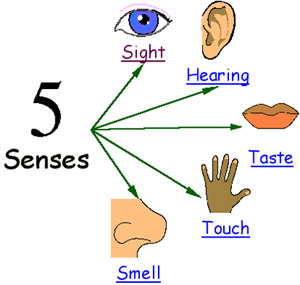 3.Read about senses and try your interpreter’s skills. Fill in the gaps with the proper names of the senses. There are five main senses - touch, smell, taste, hearing and sight. These are the external sensory system, because they tell you about the world outside your body. Your senses tell you what is happening in the outside world. Your body's sense organs constantly send signals about what is happening outside and inside it to your control center - the brain. _________________: The ability to detect and interpret odours. The organ of olfaction is the nose. It is a "chemical sense". __________________: The ability to see - that is, to detect light waves and interpret them into the objects around us. The organ of vision is the eye. __________________: The ability to detect and interpret chemical differences in items we put in the mouth, which is the organ of gustation. It is the other "chemical sense". ___________________: The ability to detect and interpret sound waves. The organ of audition is the ear. ___________________: The ability to perceive and interpret temperature, pressure and pain. The main organ of this sense is the skin, which is also the largest organ of the human body. However, there are also receptors located throughout the body. Senses are all controlled by the Nervous System. 4 .Match the idiomatic expressions with their definitions. Learn them
5. Make up a story using these idiomatic expressions РАЗДЕЛ III. THE MEDICAL INSTITUTIONS Цели раздела В результате изучения теоретического материала по темам данного раздела вы должны знать:
уметь:
Обучающие цели:
TOPIC 18. THE POLYCLINIC 1. Student: Here is a funny verse about the places people go to from time to time. Fill in the gaps using the words shop / hall / club / net / college / polyclinic |

